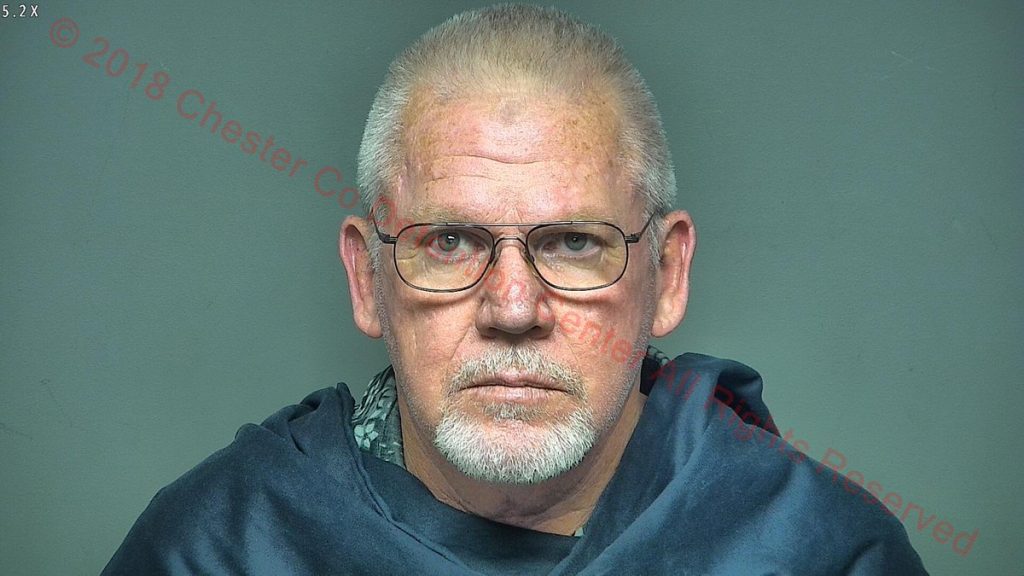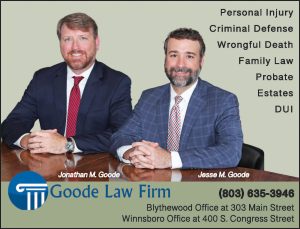
CHESTER _ On the seventh and final day of the murder trial of James Baldwin, by unanimous vote a Lancaster County jury found him guilty of killing his wife, Judy in 2016.
Closing arguments from both the prosecution and the defense in the seventh day of the trial had to do with what the evidence presented in the earlier days of the trial indicated.
Sixth Circuit Deputy Solicitor Candice Lively told the jury, “the devil is in the details,” and proceeded to lay out the state’s case based on those details.
“But for those details and the defendant manipulating every scene and altering every scenario, but for that, he probably could have gotten away with it,” Lively said.
Lively opened her closing argument by stating that the accused “Lost control of his life and his ability to do the things that he wanted to do: have a relationship with Teri King, have his bike club go wherever he wanted. He attacked and killed Judy Baldwin (on Dec. 14, 2016) because she was confronting him about his affair with Teri King,” Lively said.
Lively said the state’s case was that the evidence indicated that Baldwin beat his wife to death and at first staged the accident in the home to make it look like she fell against a metal stocking holder on a mantle while on a ladder decorating a Christmas tree. When he saw the extent of her injuries, his 22 years’ experience as a law enforcement officer and 911 dispatcher told him that the severity of her injuries couldn’t be explained by a simple fall, so he staged an automobile accident on Old Richburg Road where he claimed the Jeep he was taking her to the hospital in went down an embankment and crashed into a tree, during which time Judy was thrown from the vehicle.
She said the fact the Chester County Sheriff’s office in 2016 failed to do their due diligence in investigating the incident “is on them.” She pointed out that Baldwin was seen in a Facebook post with then-Sheriff Alex Underwood; Lively later called the investigation by the Sheriff’s investigators “trash”.
That fact, she told the jury members, “is something you have to consider as to why things were not done.”
Lively then methodically went over the evidence presented in the trial from witnesses, including details of incidents leading up to the alleged murder that showed a deteriorating relationship between Baldwin and his wife and showed how his life was coming apart: friends leaving the bike club he enjoyed, that provided recreation and access to Teri King, with whom he was having an affair, an awkward family Thanksgiving where everyone could “feel the tension in the air” between Baldwin and Judy.
Lively pointed to Baldwin’s law enforcement and dispatch experience, pointing out that a dispatcher and first responder would know the quickest way to get from one place to another in the county they work in, and not take the longer direction on a dark road that Baldwin took to get Judy Baldwin to Piedmont Medical Center.
Baldwin, Lively said, “would know the best way to get help for a person you love to make sure they are not suffering, continuing to bleed and then ultimately, die.”
Lively then showed an almost minute by minute breakdown of the timeline the night of the murder, pointing out the four hour gap between the last time Judy Baldwin was heard from at 7:13 p.m. and when the 911 call came in at 11:04 p.m.
“The defendant cannot get away from the timeline and the gap of time when Judy was beaten up until the time he calls 911 at 11:04 p.m.,” she said.
“The last thing that we know happens where Judy is still alive is a 7:13 p.m. phone call with her sister. The next thing, we have about a four-hour gap there where we have no idea what he’s doing. But I will give you exactly what he was doing.”
She added, “now that you know everything that happened in this case, from EMS showing up, fire department showing up, SCHP, listen to what Baldwin says in this 911 call.”
Lively then played the 911 call Baldwin made where he said they ran off the road on Old Richburg Road and Judy had been thrown out of the vehicle when the vehicle went down in an embankment.
“She’s not doing anything,” Baldwin said after being prompted by the 911 operator to check if Judy was breathing.
Lively said, “This man with 22 years of law enforcement experience, he knows when he tells dispatch that she’s been thrown from the vehicle, he knows what’s going to happen next. And that is it’s a motor vehicle collision; Highway Patrol is going to show up. Fire is going to show up. But at that time until SCHP Sgt. Rikard said (the accident) doesn’t look right, it doesn’t fit, that’s when he called his supervisor and says ‘call Chester County investigators.’ And only then did this become something other than a motor vehicle collision.”
She said this has all happened within a few brief hours when Judy Baldwin was attacked and killed.
“With everything that’s being said at this point, has (Baldwin) been able to formulate whether it is going to fit with the facts of the case? How is he going to make it fit with what the evidence is going to show, and he knows this,” Lively said.
Lively pointed out that at the hospital the defendant calls Teri King, but does not call either of Judy’s boys, and when Teri suggests calling “the Orr boys”, he says no, they’re at work, which attitude Lively charged goes toward his intent, what his mind was thinking and his malice and uncaring.
Baldwin then tells Dr. Miller at PMC that he has no head pain and had no loss of consciousness, Lively said.
She then points out Chris Reynolds with Chester County Sheriff’s Office later gets consent to enter the home while Baldwin a few hours later is interviewed by the SCHP.
At that point, Baldwin begins controlling the narrative, Lively says, telling Sgt. Rikard when he woke up (although he told the PMC doctor earlier there was no loss of consciousness) he was “in the creek” and he had hit his head.
“He’s already starting to control the narrative. He realizes ‘I need to let them know I don’t know how she got out of that vehicle’ because none of it is making sense at any point, and he realizes this,” Lively said.
Baldwin reported when he found Judy she was up under the front of the Jeep. When asked by Sgt. Rikard, Baldwin said the blood got on the front bumper when he tried to pick Judy up.
The state maintained he placed Judy Baldwin in front of the vehicle to make it look like an accident.
Lively said Baldwin chose to be on the darkest road in Chester County because he had time on that dark road to set the scene and get it right, staging the accident to explain Judy’s severe injury to the head.
“The important detail is he’s changing his story; he’s changed it in two big ways. ‘Oh, yeah, I did get knocked out so I don’t know what happened’ and then ‘the blood got on the front of the Jeep because I was trying to pick her up. He’s starting to try and explain away the evidence,” Lively said.
Lively went over the SCHP MAIT (Multidisciplinary Accident Investigation Team) accident investigation. The accident reconstruction shows there was no event to trigger the “black box” that controls the airbags and evidence shows the vehicle never went over five miles per hour driving down the embankment and only went fast enough when swerving off the road initially (when Baldwin alleges he was run off the road by a truck) to leave tire impressions instead of tracks), the vehicle never rolled over and there was no way Judy Baldwin was ejected from the vehicle, Lively said.
Lively contended that when Baldwin got to the bottom of the creek, he looked over at Judy, knew she was dead, her blood saturating the seat, he gets her out and places her at the front of the Jeep. But Judy Baldwin bled out in the Jeep, Lively said.
James Baldwin “placed her in that seat and then he went inside and set the scene for the first attempt to show an accident…He put her in that Jeep and let her bleed, goes into the bathroom, washed up, takes off the bloody clothes that he has on…she could have sat there and bled in that seat for three or four hours,” Lively said.
So why did Baldwin kill her? It’s all about control, Lively explained. Baldwin lost control of the life he wanted.
Lively then summarized testimony from many of the prosecution witnesses, including many first responders, one of which testified that Judy Baldwin had “raccoon eyes,” which means a person has a traumatic injury to their head resulting in blood pooling in their eyelids.
Baldwin’s law enforcement experience let him know when Judy Baldwin’s eyes started to swell shut (after he had beaten her following an argument) that she had a skull fracture or brain injury: injuries that couldn’t be explained by a fall from a ladder, so he concocted the auto accident.
The pathologist who testified on the results of the first autopsy said there looked like two possible sites of impact to Judy Baldwin’s head, maybe three and the severity of the injuries meant she would have had to fallen from a significant height to suffer a skull fracture.
The board certified forensic pathologist who conducted the second autopsy said what the defendant was saying happened didn’t fit the level of injuries Judy Baldwin suffered from a fall off of a stepladder.
“Look at the evidence,” Lively told the jury. “Look at what’s reasonable.”
She said Chester County Coroner Terry Tinker “wanted to get the investigation right” and he met resistance from the Chester County Sheriff’s Office and said the sheriff should have called in SLED on the investigation.
Lively charged the sheriff’s investigators “fed” Baldwin information about the scene and gave him “ways out” to explain things so it sounded like an accident and this actually helped Baldwin control the narrative of what happened.
She then went over the testimony of the witnesses, who imparted such facts as Judy Baldwin didn’t ever climb ladders; a neighbor testified that Judy was already finished decorating the Christmas tree; Judy’s nephew Rodney Wright testified he went to the residence on the night Judy died and the ladder was upright (instead of leaned over on the Christmas tree as is shown in pictures taken inside the residence hours later) and he said there was so much blood someone should have called 911; another friend testified that Baldwin never used old Richburg Road to get to I-77.
The SLED crime scene specialist who did an analysis of the house testified that blood was found all the way up the wall and high up on the mantle. Even the expert witness on blood splatter that the defense brought on said the blood high on the wall and up on the mantel was blood that was being cast off or flung from “something swung upward after the injury actions occurred.” The expert witness said he could not rule out that an attack had taken place.
Finally, Lively showed a comparison of the defendant’s words during an interview at the hospital on Dec. 15 and the interview with the Chester County Sheriff’s Office six days later and pointed out the details Baldwin related did not match in those two interviews.
“James Baldwin killed Judy Baldwin with malice aforethought,” Lively contended.
In the closing arguments from the defense, attorney Phillip Jamieson’s main contention was the state’s case “seemed to indicate that my client was a criminal mastermind or a fool, but can’t be both.” He said the evidence and the science of the evidence did not support the state’s claim, saying they relied on “circumstantial evidence, innuendo, half-truths and character assassinations” to prove their case.
He told the jury the prosecution hoped they would assume a lot from the witness testimony, but their job was not to assume, but to determine the facts.
After deliberating for more than three hours, the jury returned a verdict of guilty. The family of Judy Orr Baldwin reacted with tears of relief when they heard the verdict.
In an emotional victim impact statement before sentencing, Judy’s son Chris Orr asked Judge Dan Hall to impose the maximum sentence on James Baldwin.
“My brother and I knew that our momma would have called and spoke to us. I’m sure she begged for her life. (James Baldwin) deserves death. He doesn’t deserve to breathe the air of anyone in this room,” Chris Orr said.
After hearing a statement from Baldwin’s attorneys where they pointed to his age and his long service to the community in law enforcement and asked the court to take that into consideration, Judge Hall sentenced Baldwin to life imprisonment.











